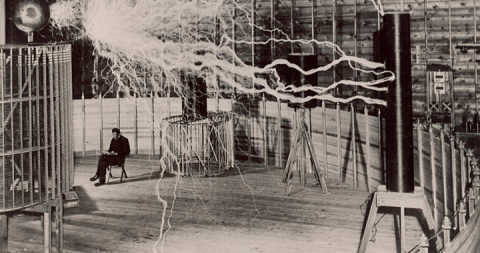Nikola Tesla was born on July 10, 1856, in the village of Smiljan, which was then part of the Austrian Empire and is now located in modern-day Croatia. He was the fourth of five children in a Serbian family; his father, Milutin Tesla, was an Eastern Orthodox priest, and his mother, Đuka Mandić, came from a family of inventors and was known for her ingenuity in creating household appliances despite lacking formal education.
Tesla credited his mother for sparking his interest in invention. From a young age, Tesla exhibited remarkable intellectual abilities, including an eidetic memory and a fascination with electricity, inspired by natural phenomena like thunderstorms. Tragically, his older brother Dane died in a horse-riding accident when Tesla was five, an event that profoundly affected him and may have contributed to his lifelong eccentricities and phobias.
As a child, Tesla suffered from various illnesses and experienced vivid hallucinations, which he later described as flashes of light accompanied by creative insights. He attended primary school in Smiljan and Gospić, where he excelled in mathematics and languages, mastering several European tongues. In 1870, he moved to Karlovac to attend higher secondary school, completing a four-year program in three years due to his prodigious talents.
Tesla pursued higher education at the Austrian Polytechnic in Graz in 1875, where he studied mechanical and electrical engineering. He impressed professors with his brilliance but clashed over academic requirements, leaving without a degree after his first year due to a gambling addiction that depleted his tuition funds.
He briefly worked as a draftsman in Maribor before suffering a nervous breakdown in 1878. Reuniting with his family, he enrolled at Charles-Ferdinand University in Prague in 1880 but attended only one term following his father’s death.
In 1881, Tesla moved to Budapest to work for the Budapest Telephone Exchange under Tivadar Puskás. There, he made improvements to equipment and reportedly conceived the idea of the induction motor while walking in a park, visualizing a rotating magnetic field – a breakthrough that would define his career.
He then worked briefly in Paris for the Continental Edison Company, troubleshooting power plants across Europe. In 1884, at age 28, Tesla immigrated to the United States with little money, arriving in New York City to work for Thomas Edison.
Tesla joined Edison Machine Works, where he redesigned dynamos and solved engineering problems, reportedly working 18-hour days. A famous rift emerged when Edison promised Tesla $50,000 for improving his direct current (DC) generators, only to dismiss it as a joke upon completion. Tesla quit in 1885, feeling betrayed. This was called “war of the currents” highlighted the rivalry between Edison’s DC system and Tesla’s advocacy for alternating current (AC), which could transmit power over longer distances more efficiently.
In 1886, Tesla founded Tesla Electric Light & Manufacturing but was ousted by investors. He labored as a ditch digger to survive before securing funding in 1887 to develop his AC induction motor. Partnering with George Westinghouse, who bought Tesla’s patents for $60,000 plus royalties, they promoted AC systems. Their victory came when Westinghouse’s AC powered the 1893 World’s Columbian Exposition in Chicago and later the Niagara Falls hydroelectric plant in 1896, establishing AC as the standard for electrical distribution.
Tesla’s inventions revolutionized electricity and beyond. His most pivotal was the AC polyphase system, including the induction motor and transformers, patented in 1888, enabling efficient power generation and transmission. He invented the Tesla coil in 1891, a high-voltage transformer used in radio technology and still featured in demonstrations today.
Tesla pioneered wireless communication, demonstrating radio-controlled boats in 1898 and envisioning global wireless power. Though Guglielmo Marconi is credited with radio, the U.S. Supreme Court ruled in 1943 that Tesla’s patents preceded Marconi’s.
Other achievements include early X-ray experiments, contributions to radar and remote control, and concepts for hydroelectric power, as seen in his Niagara Falls work. In Colorado Springs (1899-1900), he conducted high-voltage experiments, creating artificial lightning and studying wireless transmission. Tesla held over 300 patents worldwide, though many ideas, like the “death ray” particle beam, remained theoretical.
Despite financial success from patents, Tesla waived royalties during Westinghouse’s 1907 crisis, prioritizing AC adoption over personal wealth.
In the early 1900s, Tesla built the Wardenclyffe Tower on Long Island for wireless transmission but abandoned it in 1906 due to funding shortages from investor J.P. Morgan. Increasingly reclusive, Tesla lived in New York hotels, accruing debts while pursuing visionary projects like turbine engines and vertical takeoff aircraft. He suffered from obsessive-compulsive behaviors, a fear of germs, and a preference for the number three.
Impoverished in his later years, Tesla received a pension from Yugoslavia and occasional support from Westinghouse. He died alone on January 7, 1943, at age 86 in the New Yorker Hotel from coronary thrombosis. His papers were seized by the U.S. government amid World War II concerns but later released.
Tesla’s legacy endures as a symbol of innovation and underappreciated genius. His AC system powers the modern world, underpinning global electricity grids and enabling the Second Industrial Revolution. Ideas on wireless energy influenced radio, television, and the internet, while his work foreshadowed technologies like Wi-Fi, drones, and renewable energy.
Posthumously honored, the tesla unit measures magnetic flux density, and institutions like the Nikola Tesla Museum in Belgrade preserve his artifacts.
Tesla’s emphasis on sustainable energy resonates today amid climate challenges, cementing his role as a pioneer whose inventions transformed society.
© Times of U

